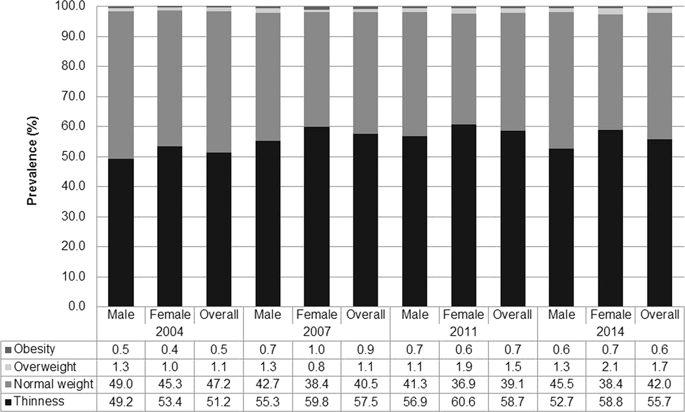当前位置:
X-MOL 学术
›
Int. J. Obesity
›
论文详情
Our official English website, www.x-mol.net, welcomes your feedback! (Note: you will need to create a separate account there.)
Trends in the prevalence of overweight among Bangladeshi children aged 24-59 months (2004-2014) by sex and socioeconomic status.
International Journal of Obesity ( IF 4.9 ) Pub Date : 2019-12-17 , DOI: 10.1038/s41366-019-0507-9 Md Shajedur Rahman Shawon 1 , Fariha Binte Hossain 2 , Blake Thomson 3 , Gourab Adhikary 4 , Arif Chowdhury 5 , Rajiv Chowdhury 6 , Nick Townsend 7
International Journal of Obesity ( IF 4.9 ) Pub Date : 2019-12-17 , DOI: 10.1038/s41366-019-0507-9 Md Shajedur Rahman Shawon 1 , Fariha Binte Hossain 2 , Blake Thomson 3 , Gourab Adhikary 4 , Arif Chowdhury 5 , Rajiv Chowdhury 6 , Nick Townsend 7
Affiliation

|
BACKGROUND
While recent evidence suggests that the overall prevalence of overweight in young children in Bangladesh is low, little is known about variation in trends by sex, socioeconomic status, urbanicity, and region. We investigated the trends in overweight among children aged 24-59 months by these factors, using nationally representative samples from Bangladesh Demographic and Health Surveys (BDHS) between 2004 and 2014.
METHODS
Data from four BDHS surveys conducted between 2004 and 2014, with valid height and weight measurements of children, were included in this study (n = 15,648). BMI was calculated and the prevalence of overweight (including obesity) was reported using the International Obesity Taskforce (IOTF) classification system. To explore the association between socioeconomic status and childhood overweight, we used multivariable logistic regression.
RESULTS
The overall prevalence of overweight among children aged 24-59 months increased from 1.60% (95% CI: 1.20-2.05%) in 2004 to 2.33% (95% CI: 1.82-2.76%) in 2014. Among girls, the overweight trend increased significantly (adjusted odds ratio (OR) comparing 2014 vs. 2004: 2.02 95% CI: 1.52-2.68), whereas among boys the trend remained steady. When compared with households with the poorest wealth index, households with richest wealth index had higher odds of childhood overweight among both boys (OR 2.39, 95% CI: 1.76-3.25) and girls (OR 1.86, 95% CI: 1.35-2.55). Higher household education level was also associated with childhood overweight. Subgroup analyses showed that relative inequalities by these factors increased between 2004 and 2014 when adjusted for potential confounders.
CONCLUSIONS
There is a rising trend in overweight prevalence exclusively among girls aged 24-59 months in Bangladesh. Childhood overweight is associated with higher household education and wealth index, and the relative disparity by these factors appears to be increasing over time. These unmet inequalities should be considered while developing national public health programs and strategies.
中文翻译:

按性别和社会经济地位分列的孟加拉国24-59个月大儿童(2004-2014年)超重流行率趋势。
背景技术虽然最近的证据表明孟加拉国幼儿的总体超重患病率较低,但对性别,社会经济地位,城市化程度和地区的趋势变化知之甚少。我们使用孟加拉国人口与健康调查(BDHS)在2004年至2014年期间的全国代表性样本,通过这些因素调查了24-59个月儿童的超重趋势。方法2004年至2014年之间进行的四次BDHS调查的数据均具有有效身高这项研究包括儿童的体重和体重测量(n = 15648)。使用国际肥胖特别工作组(IOTF)分类系统计算了BMI,并报告了超重(包括肥胖)的患病率。为了探索社会经济地位与儿童超重之间的关系,我们使用了多元Logistic回归。结果24至59个月大的儿童中超重的总体患病率从2004年的1.60%(95%CI:1.20-2.05%)增加到2014年的2.33%(95%CI:1.82-2.76%)。趋势显着增加(2014年与2004年相比,调整后的优势比(OR):2.02 95%CI:1.52-2.68),而男孩中这一趋势保持稳定。与财富指数最差的家庭相比,男孩(OR 2.39,95%CI:1.76-3.25)和女孩(OR 1.86,95%CI:1.35-2.55)中,财富指数最高的家庭的儿童超重几率更高。家庭教育水平较高还与儿童超重有关。亚组分析显示,在针对潜在混杂因素进行调整后,这些因素带来的相对不平等现象在2004年至2014年之间有所增加。结论孟加拉国仅在24至59个月大的女孩中,超重流行率呈上升趋势。儿童超重与较高的家庭教育程度和财富指数有关,并且这些因素的相对差距似乎随着时间而增加。在制定国家公共卫生计划和战略时应考虑这些未得到满足的不平等现象。
更新日期:2019-12-18
中文翻译:

按性别和社会经济地位分列的孟加拉国24-59个月大儿童(2004-2014年)超重流行率趋势。
背景技术虽然最近的证据表明孟加拉国幼儿的总体超重患病率较低,但对性别,社会经济地位,城市化程度和地区的趋势变化知之甚少。我们使用孟加拉国人口与健康调查(BDHS)在2004年至2014年期间的全国代表性样本,通过这些因素调查了24-59个月儿童的超重趋势。方法2004年至2014年之间进行的四次BDHS调查的数据均具有有效身高这项研究包括儿童的体重和体重测量(n = 15648)。使用国际肥胖特别工作组(IOTF)分类系统计算了BMI,并报告了超重(包括肥胖)的患病率。为了探索社会经济地位与儿童超重之间的关系,我们使用了多元Logistic回归。结果24至59个月大的儿童中超重的总体患病率从2004年的1.60%(95%CI:1.20-2.05%)增加到2014年的2.33%(95%CI:1.82-2.76%)。趋势显着增加(2014年与2004年相比,调整后的优势比(OR):2.02 95%CI:1.52-2.68),而男孩中这一趋势保持稳定。与财富指数最差的家庭相比,男孩(OR 2.39,95%CI:1.76-3.25)和女孩(OR 1.86,95%CI:1.35-2.55)中,财富指数最高的家庭的儿童超重几率更高。家庭教育水平较高还与儿童超重有关。亚组分析显示,在针对潜在混杂因素进行调整后,这些因素带来的相对不平等现象在2004年至2014年之间有所增加。结论孟加拉国仅在24至59个月大的女孩中,超重流行率呈上升趋势。儿童超重与较高的家庭教育程度和财富指数有关,并且这些因素的相对差距似乎随着时间而增加。在制定国家公共卫生计划和战略时应考虑这些未得到满足的不平等现象。


























 京公网安备 11010802027423号
京公网安备 11010802027423号